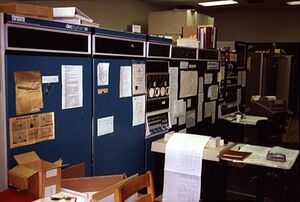WAITS
| WAITS | |
| Type: | Multi-tasking, multi-user, virtual memory |
|---|---|
| Creator: | Stanford AI Lab |
| Architecture: | PDP-10 |
| This Version: | 9.18/M |
| Date Released: | 1972 (diverged from TOPS-10) |
WAITS was the operating system used at the Stanford AI Lab. It ran on a PDP-6 (serial number 16), a KA10 (#32), and a KL10 (#1075) connected together in various configurations. The name unofficially means "West-coast Alternative to ITS", or "West-coast Artificial Intelligence Time-Sharing" (although these may be a 'backronym' - a SAIL page which discusses the meaning of the name does not mention it). It also ran on PDP-10 clones at Stanford, manufactured by Foonly; one at CCRMA, and one at the S-1 project.
Much like its "cousin" ITS, WAITS has support for exotic hardware: custom made vector displays from III, raster displays from Data Disc, robotic devices, and a powerful sound synthesis device called the Samson Box.
In modern times, WAITS is running on a KL10 at the Living Computers Museum, and on Richard Cornwell's KA10 emulator. SAIL alumnus Bruce Baumgart's Saildart project has an archive of files from magnetic tape backups, and documents the history of SAIL and WAITS.
Instances
The SAIL timesharing system started 1966 on a PDP-6, running DEC's Monitor. A KA10 was added in 1968, making the PDP-6 a secondary processor for realtime tasks. In 1972, the system diverged from TOPS-10 4S72 and was initially just called the "Stanford monitor" or "Stanford system" until receiving the name WAITS. In 1976, a KL10 became the primary, making the KA10 secondary. Over the years, the PDP-6 and KA10 was retired, with the KL10 running alone until 1991.
CCRMA shared facilities with SAIL. When the KA10 arrived, CCRMA could use the PDP-6 for music research and to control the Samson Box. When the AI lab moved out, CCRMA stayed behind and arranged to run WAITS on a Foonly F2 with Grinnell framebuffers. After some years, it was upgraded to an F4.
The LLL S-1 project also ran WAITS on an F2.
Version history
Versions and events for the main WAITS track at SAIL. Offshots include CCRMA and LLL S-1 project, both running on Foonly machines.
- Previous time-sharing experiments at IMSSS include Odin, Thor, and Zeus on a PDP-1 with Philco vector displays. Many concepts were brought over to the SAIL system.
- The lab acquired a PDP-6 in June 1966.
- The SAIL monitor was based on an early PDP-6 Monitor from DEC.
- The 2 series monitor had storage on DECtapes only.
- A PDP-10 was installed September 1968.
- The 6 series introduced the use of disk file storage.
- The first monitor version recorded on tape is Stanford 6.09F, from 1972-10-02.
- The last 6 series version is Stanford 6.19/B from 1975-04-14.
- The 7 series added use of the BBN pager to extend physical memory beyond 256K
- Stanford 7.01 dates from 1975-04-19.
- The last 7 series version is Stanford 7.05/I/1400P from 1976-05-06.
- The 8 series marked the port to the KL10 processor.
- Stanford 8.00 is from 1976-06-06.
- In September 1977, the old disk controller by Phil Petit was replaced with a Foonly C1 channel.
- 1978-04-09 marks the renaming of the system with WAITS 8.70/I.
- To differentiate between sites, the machine name was added to the version string.
- The last 8 series version is SU-AI WAITS 8.73/Q from 1978-12-21.
- The 9 series monitors had the "P2 processor separate" (unclear).
- SU-AI WAITS 9.01 is from 1978-12-30.
- The processor was upgraded to a KL10 "Model B" in 1983, and the disk system moved to an RH20 controller with RP06 and RP07 drives.
- In 1988 the C1 channel was dropped, leaving WAITS with a single RP06.
- "Eventually, the insulation on the wire-wrapped backplane wires started to fail, and the CPU was kept going by strategically placing toothpicks to avoid shorts where the wires took a 90 degree turn around a pin" Source
- The ultimate version is SAIL.Stanford.EDU WAITS 9.18/M from 1990-04-26.
- WAITS was shut down permanently on Friday 7 June 1991.
See also
External links
- The Autobiography of SAIL
- The First Ten Years of Artificial Intelligence Research at Stanford
- SAILDART Prolegomenon, book draft by Bruce Baumgart
